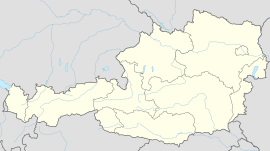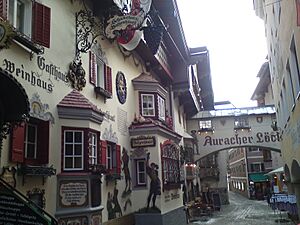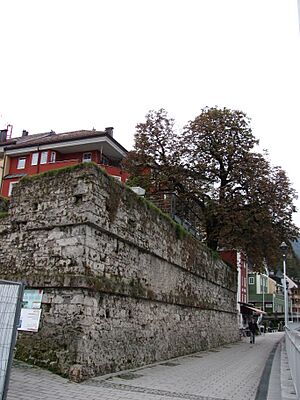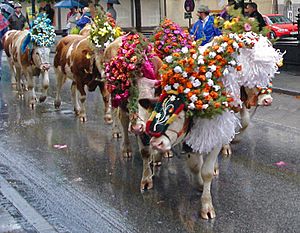Kufstein facts for kids
Quick facts for kids
Kufstein
Kufstoa
|
||
|---|---|---|
|
Municipality
|
||
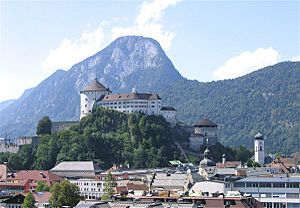
View to Kufstein Fortress and Brandenberg Alps
|
||
|
||
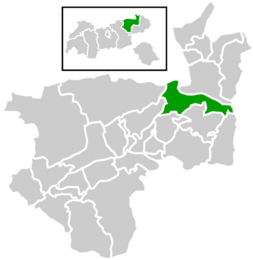
Location within Kufstein district
|
||
| Country | Austria | |
| State | Tyrol | |
| District | Kufstein | |
| Area | ||
| • Total | 39.4 km2 (15.2 sq mi) | |
| Elevation | 499 m (1,637 ft) | |
| Time zone | UTC+1 (CET) | |
| • Summer (DST) | UTC+2 (CEST) | |
| Postal code |
6330-6333
|
|
| Area code | 05372 | |
| Vehicle registration | KU | |
Kufstein is a lively town in Tyrol, Austria. It's the main town of the Kufstein District. With about 20,000 people, it's the second biggest town in Tyrol, right after Innsbruck. Its most famous landmark is the amazing Kufstein Fortress, which has been around since the 1200s!
Contents
Exploring Kufstein's Location
Kufstein is located in a beautiful area called the Tyrolean Unterland. It sits right on the Inn River, where two smaller rivers, the Weißache and Kaiserbach, join it. The town is very close to the border with Bavaria, Germany.
The town is surrounded by stunning mountains: the Brandenberg Alps to the northwest and the Kaiser Mountains to the southeast. There's a special valley called Kaisertal nearby. Until 2008, it was a very remote place with no roads! Now, a tunnel connects it to the nearby town of Ebbs.
North of Kufstein, the Inn River leaves the mountains and flows into a flatter area. Kufstein also has several small lakes, like Pfrillsee, Längsee, and Hechtsee. Some areas, like Egelsee and Maistaller Lacke, are protected nature spots.
The town is divided into different parts called quarters. These are Zentrum, Sparchen, Weissach, Endach, and Zell.
Kufstein's Weather
| Climate data for Kufstein (1971–2000) | |||||||||||||
|---|---|---|---|---|---|---|---|---|---|---|---|---|---|
| Month | Jan | Feb | Mar | Apr | May | Jun | Jul | Aug | Sep | Oct | Nov | Dec | Year |
| Record high °C (°F) | 17.3 (63.1) |
18.8 (65.8) |
25.5 (77.9) |
27.0 (80.6) |
30.6 (87.1) |
34.8 (94.6) |
36.0 (96.8) |
34.8 (94.6) |
29.7 (85.5) |
26.2 (79.2) |
23.3 (73.9) |
19.2 (66.6) |
36.0 (96.8) |
| Mean daily maximum °C (°F) | 2.1 (35.8) |
4.6 (40.3) |
9.7 (49.5) |
13.8 (56.8) |
19.2 (66.6) |
21.3 (70.3) |
23.5 (74.3) |
23.2 (73.8) |
19.4 (66.9) |
14.2 (57.6) |
6.9 (44.4) |
2.6 (36.7) |
13.4 (56.1) |
| Daily mean °C (°F) | −1.8 (28.8) |
−0.1 (31.8) |
3.9 (39.0) |
7.7 (45.9) |
12.9 (55.2) |
15.6 (60.1) |
17.6 (63.7) |
17.2 (63.0) |
13.5 (56.3) |
8.8 (47.8) |
2.8 (37.0) |
−0.8 (30.6) |
8.1 (46.6) |
| Mean daily minimum °C (°F) | −4.4 (24.1) |
−3.2 (26.2) |
0.1 (32.2) |
3.2 (37.8) |
7.7 (45.9) |
10.9 (51.6) |
12.9 (55.2) |
12.8 (55.0) |
9.6 (49.3) |
5.4 (41.7) |
0.3 (32.5) |
−3.1 (26.4) |
4.4 (39.9) |
| Record low °C (°F) | −22.8 (−9.0) |
−18.0 (−0.4) |
−17.7 (0.1) |
−4.8 (23.4) |
−2.4 (27.7) |
2.8 (37.0) |
4.5 (40.1) |
3.9 (39.0) |
−0.9 (30.4) |
−6.3 (20.7) |
−14.8 (5.4) |
−20.1 (−4.2) |
−22.8 (−9.0) |
| Average precipitation mm (inches) | 81.3 (3.20) |
72.0 (2.83) |
93.3 (3.67) |
95.4 (3.76) |
109.8 (4.32) |
155.4 (6.12) |
175.4 (6.91) |
152.5 (6.00) |
102.3 (4.03) |
73.1 (2.88) |
95.2 (3.75) |
88.0 (3.46) |
1,293.7 (50.93) |
| Average snowfall cm (inches) | 41.2 (16.2) |
37.6 (14.8) |
27.5 (10.8) |
10.8 (4.3) |
0.1 (0.0) |
0.0 (0.0) |
0.0 (0.0) |
0.0 (0.0) |
0.0 (0.0) |
0.4 (0.2) |
22.2 (8.7) |
36.2 (14.3) |
176.0 (69.3) |
| Average precipitation days (≥ 1.0 mm) | 10.3 | 9.5 | 12.4 | 12.6 | 12.7 | 15.7 | 15.5 | 14.1 | 10.9 | 9.5 | 10.9 | 11.3 | 145.4 |
| Average relative humidity (%) (at 14:00) | 71.3 | 62.0 | 53.1 | 49.0 | 48.4 | 53.1 | 54.0 | 55.4 | 58.2 | 61.1 | 69.9 | 75.9 | 59.3 |
| Source: Central Institute for Meteorology and Geodynamics | |||||||||||||
Kufstein's Growing Population
| Historical population | ||
|---|---|---|
| Year | Pop. | ±% |
| 1869 | 2,777 | — |
| 1880 | 3,787 | +36.4% |
| 1890 | 4,067 | +7.4% |
| 1900 | 4,791 | +17.8% |
| 1910 | 6,717 | +40.2% |
| 1923 | 7,103 | +5.7% |
| 1934 | 7,551 | +6.3% |
| 1939 | 8,233 | +9.0% |
| 1951 | 11,268 | +36.9% |
| 1961 | 11,215 | −0.5% |
| 1971 | 12,913 | +15.1% |
| 1981 | 13,118 | +1.6% |
| 1991 | 13,484 | +2.8% |
| 2001 | 15,358 | +13.9% |
| 2011 | 17,388 | +13.2% |
| 2015 | 20,064 | +15.4% |
Kufstein has grown a lot over the years. In 1869, there were only about 2,700 people living here. By 2015, the population had grown to over 20,000! This shows how the town has become more important and attracted more people.
Kufstein's Economy and Businesses
Kufstein is home to several important companies.
- Riedel is a famous company that makes beautiful glass products.
- LKW Walter is a big company that helps transport goods.
- Voere makes guns.
- Kleen-Tex produces textile mats.
The town also has the University of Applied Sciences Kufstein. This university focuses on business education. It's a great place for students from all over the world to study and learn.
Getting Around Kufstein
Kufstein is easy to reach by car and train.
- The A12 motorway (a big highway) has two exits for Kufstein. This road connects Innsbruck to Rosenheim.
- The Kufstein railway station opened in 1876. It's part of a major railway line that goes from Munich all the way to Verona.
- The Festungsbahn is a funicular, which is like a small train that goes up a steep hill. It connects the town center to the Kufstein Fortress.
Kufstein's Rich History
Kufstein has a very long and interesting history.
- Scientists have found signs of people living in the Tischofer Cave in Kaisertal over 30,000 years ago! These are the oldest signs of humans in Tyrol.
- Around 15 BC, the Roman Empire took over the area. The Inn River became a border between two Roman provinces.
- A church in Kufstein was first mentioned in a document from 788. At that time, the area was part of Bavaria.
- The Kufstein Fortress was first mentioned in 1205. It belonged to the Bishop of Regensburg and the Duke of Bavaria.
In the early 1300s, the Bavarian Duke Louis IV gave Kufstein's citizens special rights. Kufstein became part of County of Tyrol in 1342. This happened when Countess Margaret received it as a wedding gift. However, it went back to Bavaria when she died in 1369.
In 1393, Duke Stephen III gave Kufstein "city status." This was because it was an important place for trade and boats on the Inn River. Later, his son, Duke Louis VII, rebuilt and made the Fortress much bigger.
The Kufstein Fortress was very important because of its location on the border. In 1504, Emperor Maximilian I of the Habsburg family took over the town during a war. The next year, it officially became part of Tyrol. Maximilian then built the famous Kaiserturm tower at the fortress, finishing it in 1522.
During the War of the Spanish Succession in 1703, Bavarian troops tried to take the castle again. But Kufstein remained Austrian. In 1805, after another war, Kufstein became part of the Kingdom of Bavaria. The Tyrolean Rebellion of 1809 was put down by the Bavarian Army. Finally, in 1813/14, Kufstein became part of the Austrian Empire again.
In the 1800s, Kufstein Fortress was used as a prison for political prisoners. One famous prisoner was Sándor Rózsa from Hungary. He was later pardoned in 1868. The town's economy grew a lot after the Lower Inn Valley Railway opened in 1858.
Towards the end of World War II, the old town center was damaged by bombs. After the war, Kufstein was occupied by French and US soldiers. It also had a camp for people who had been displaced from their homes during the war.
Amazing Sights in Kufstein
Kufstein has many interesting places to see because of its long history.
- The Fortress (Festung) is built on a rock that is 90 meters (about 295 feet) high. It was first mentioned in a document in 1205. It was made bigger many times. The most important tower, the round Kaiserturm, was built between 1518 and 1522. The fortress was used as a prison sometimes. Today, it's famous for its huge organ, called the Heldenorgel.
- The Old City Center (Altstadt) has many charming, old lanes. The most famous one is Römerhofgasse.
- The City Hall (Rathaus) is a beautiful building located on a square called Stadtplatz.
- Saint Vitus Church is the oldest church in Kufstein. It was built between 1390 and 1420 in a Gothic style. Later, it was changed to a baroque style church in 1660-1661.
- The Medieval City Wall is still partly standing and is worth seeing. The Wasserbastei is a cool part of the wall by the Inn River in the north of the old city. In the south, you can see a former gate called Auracher Löchl.
Kufstein's International Friends
Kufstein has "twin towns" or "sister cities" in other countries. This means they have special friendly relationships and often share culture and ideas.
 Frauenfeld, Switzerland
Frauenfeld, Switzerland Rovereto, Italy
Rovereto, Italy Langenlois, Austria
Langenlois, Austria
Famous People from Kufstein
Many interesting people have come from Kufstein.
- Josef Madersperger (1768–1850), a tailor who helped invent the sewing machine.
- Norbert Pfretzschner (1850–1927), a sculptor and writer.
- Max Reisch (1912–1985), an explorer and writer who studied the Orient.
- Claus Josef Riedel (1925–2004), a business owner and designer of glass.
- Günter Pichler (born 1940), a talented musician and professor.
- Christian Planer (born 1975), an Olympic bronze medalist in sport shooting.
- Nicole Billa (born 1996), a professional footballer who plays for the Austrian women's team.
See also
 In Spanish: Kufstein para niños
In Spanish: Kufstein para niños



